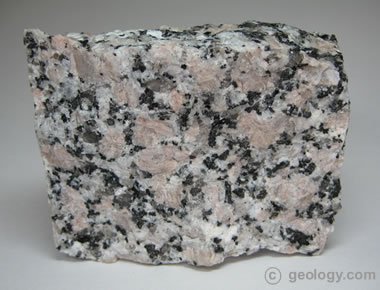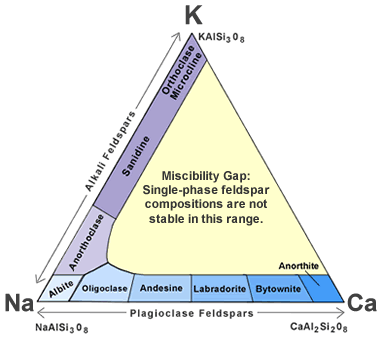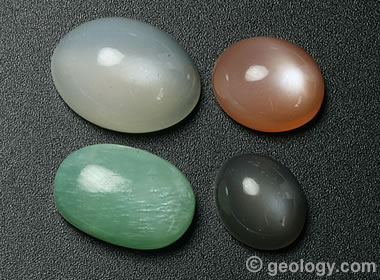
Pink Granite: A specimen of coarse-grained granite with pink crystals of orthoclase. This specimen is approximately two inches across.
What Is Orthoclase?
Orthoclase is a feldspar mineral with a chemical composition of KAlSi3O8. It is one of the most abundant rock-forming minerals of the continental crust. Orthoclase is most widely known as the pink feldspar found in many granites and as the mineral assigned a hardness of "6" in the Mohs hardness scale.
Uses of Orthoclase
Orthoclase has several commercial uses. It is a raw material used in the production of glass, ceramic tile, porcelain, dinnerware, bathroom fixtures, and other ceramics. It is used as an abrasive in scouring powders and polishing compounds. It is also cut as a gemstone. An adularescent gem material known as moonstone is an intergrowth of orthoclase and albite.

Minerals in Igneous Rocks: This chart shows the generalized ranges of mineral abundance in the most common igneous rocks. It shows orthoclase as a major constituent in granites and rhyolites and in some diorites and andesites.
Geologic Occurrence of Orthoclase
Most orthoclase forms during the crystallization of a magma into intrusive igneous rocks such as granite, granodiorite, diorite, and syenite. Significant amounts of orthoclase are also found in extrusive igneous rocks such as rhyolite, dacite, and andesite.
Large crystals of orthoclase are found in igneous rocks known as pegmatite. They are normally no more than a few inches in length, but the largest reported orthoclase crystal was over 30 feet in length and weighed about 100 tons. It was found in a pegmatite in the Ural Mountains of Russia.
During physical weathering, grains of orthoclase are incorporated into sediments and sedimentary rocks such as sandstone, conglomerate, and siltstone. Chemical weathering alters orthoclase into clay minerals such as kaolinite in reactions similar to the one shown below.
2KAISi3O8 + 2H+ + 9H2O → H4Al2Si2O9 + 4H4SiO4 + 2K+
(orthoclase + water → kaolinite + silicic acid + potassium)
Orthoclase is also a significant constituent of the metamorphic rocks known as gneiss and schist. These rocks most often form during regional metamorphism when granitic rocks are subjected to heat and pressure at convergent plate boundaries involving continental crust. The orthoclase in these metamorphic rocks is inherited from their igneous protoliths.
Orthoclase on the Moon and Mars
Orthoclase is also known in igneous rocks found on the moon and on Mars. Orthoclase is an important constituent of igneous rocks brought back from the moon by astronauts. It has also been detected in the igneous rocks of Mars during analyses done by NASA’s rovers.

Feldspar Mineral Classification: This ternary diagram shows how feldspar minerals are classified on the basis of their chemical composition. The sequence of minerals along the left side of the triangle represents the solid solution series of the alkali feldspars. Orthoclase is in the position of extreme potassium content.
Orthoclase as a Feldspar Mineral
Orthoclase is a member of the alkali feldspar series. The alkali feldspars include albite (NaAlSi3O8), anorthoclase ((Na,K)AlSi3O8), sanidine ((K,Na)AlSi3O8), orthoclase (KAlSi3O8), and microcline (KAlSi3O8).
These feldspar minerals form a solid solution series between NaAlSi3O8 and KAlSi3O8. The minerals in that series crystallize from melts that usually contain both sodium and potassium ions. At the time of crystallization, these ions can substitute freely for one another in the mineral’s crystal structure. Because of this the alkali feldspars exist in a range of chemical compositions between pure albite (NaAlSi3O8) and pure orthoclase (KAlSi3O8). A chart summarizing their continuum of compositional relationships is shown.
Because orthoclase is rich in potassium and an end member of the alkali feldspar series, many geologists call it "K-spar," "K-feldspar" or "potassium feldspar."
Physical Properties of Orthoclase |
|
| Chemical Classification | Silicate |
| Color | White, gray, pink, reddish, yellow, green, colorless |
| Streak | White |
| Luster | Vitreous, pearly on cleavage faces |
| Diaphaneity | Translucent to transparent |
| Cleavage | Perfect in two directions intersecting at 90 degrees |
| Mohs Hardness | 6 |
| Specific Gravity | 2.5 to 2.6 |
| Diagnostic Properties | Cleavage, color |
| Chemical Composition | KAlSi3O8 |
| Crystal System | Monoclinic |
| Uses | Ceramics, glass, abrasives, gemstones, Mohs scale mineral |
Physical Properties of Orthoclase
All feldspar minerals are usually translucent to transparent, display two directions of cleavage that intersect at approximately 90 degrees, have a vitreous to pearly luster on cleavage faces, and have a specific gravity between about 2.5 and 2.6. Because of these similarities, the feldspar minerals can be challenging to identify with absolute confidence in the field or the introductory classroom. This becomes more difficult when their crystals are part of an igneous rock with a grain-size of just a few millimeters or less. Special mineralogical or gemological testing equipment is often needed to positively identify the feldspar minerals.

Specimen Grade vs. Facet Grade Orthoclase: Photo of an orthoclase crystal from the Fianarantsoa Province of Madagascar with a superb crystal form and color. A crystal like this would have a much higher price if sold as a mineral specimen than as a piece of facet rough. Specimen and photo by Arkenstone / www.iRocks.com.

Colored Moonstone: Moonstone cabochons in a variety of colors.
Orthoclase Gemology
As a mineral with a Mohs hardness of 6 and two directions of perfect cleavage, orthoclase is not an especially durable gemstone. It will develop abrasions if used in most types of jewelry, and it can easily cleave upon impact. For these reasons, orthoclase is more of a "collectors gem" than a gem for use in jewelry.
Transparent Orthoclase
Transparent orthoclase with superior clarity is sometimes faceted and sold as a collector’s gem. These gems commonly range from colorless to a bright yellow color. If the specimen is a well-formed crystal, it will likely have a much higher value if sold as a mineral specimen than as a cutting rough.
Moonstone
Moonstone is the most famous orthoclase gem. Moonstone is a translucent to transparent material that consists of alternating layers of orthoclase and albite feldspar. As light penetrates a moonstone cabochon, some of that light scatters at the boundaries between the two interlayered feldspar materials. The scattered light illuminates the stone and produces a phenomenal glow that appears to move beneath the cabochon’s surface. The glow appears to move as the light source is moved, or as the stone is moved, or as the observer chances his angle of observation.
The glow is usually white in color and is the source of the "moonstone" name. The gemological name used for this phenomenon is "adularescence," which is derived from "adularia," an old European name for moonstone.
| More Minerals |
 |
Herkimer Diamonds |
 |
The Acid Test |
 |
Tumbled Stones |
 |
Zircon |
 |
Fool*s Gold |
 |
Kyanite |
 |
Rock Tumblers |
 |
Rhodochrosite |

Find Other Topics on Geology.com:

|

| ||

|

| ||

|

| ||

|

|
